Today, we are all obsessed with the experience of the customer. However, only some seem to care about employee experience. This makes no sense whatsoever.
It is common to think that customers are the drivers of our business. And while this is true, imagine what would happen if all employees from your company decided to take a couple of days off, stay home, and watch Netflix? This would be a disaster. Yet, many companies still don't see the importance of designing a better employee experience.
Contents
What is an employee journey?
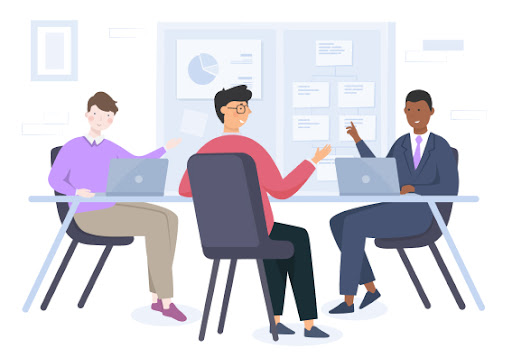
Put simply, an employee journey is the complete experience an individual has while they're employed at an organization, starting from the day they apply for the job until the day they leave. Such a journey includes every interaction they have with the organization, whether it's having a conversation with a manager, participating in a training session, or attending a team meeting. Think of it like a story that unfolds over time, each chapter representing a different part of the work life.
For example, consider Steve, who just got a job at a technology firm. His employee journey starts with applying for a job, getting an interview invitation, and having the interview. Then he has the second interview and receives the job offer, which moves Steve to the next stage — his first day of work, where he's welcomed by his colleagues and continues as he works on projects, receives feedback, and grows his skills.
Over the years, Steve might get promoted, switch to different roles within the company, or take part in special programs. His journey captures all these experiences right up until his retirement party or the moment he leaves the company, capturing the entire arc of his career at the firm.
Benefits of employee journey mapping

Why is it essential to know the state of your employees’ journeys and improve them? Many smart companies all over the world are using a very effective idea. They treat their employees really well, just like they do with their customers.
They've figured out that this is super important. In this paragraph, we'll explain why this is a big deal and how it can make companies much better in today's world.
Here are a few down-to-earth points as to why you should take employee experience seriously:
- Employee engagement means customer success. Did you know engaged employees are almost 90% less likely to leave their company compared to employees who have a low level of engagement? Leave alone the fact that engaged employees are a lot more productive.
- Employees come at a great cost. And it’s not just about money. Customers do not interact with CEOs. They interact with front-desk staff, customer support, sales, you name it. Mistakes of these people may seriously damage your company’s reputation. That alone is a good reason to start thinking about designing a better employee experience.
- Word of mouth. Finally, just like a great customer product, an outstanding employee experience gets spread by word of mouth. It becomes one of the ways you attract talented people to the company.
- Enhanced onboarding and retention. By understanding the employee journey, organizations can create a more structured and engaging onboarding process. This will help new hires become productive more quickly and feel a greater sense of belonging, which can reduce turnover rates.
Now that we’re on the same page regarding the importance of designing a better experience for employees at a company, it’s time to proceed to actionable to-dos.
Read also: Case study on improving the employee journey
Employee experience journey mapping
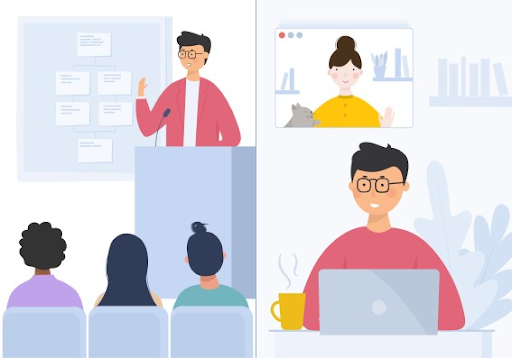
One of the proven approaches to analyzing, understanding, and enhancing the employee experience and employee journeys is a great technique called customer journey mapping.
Not familiar with this subject? Check out our complete guide on creating a customer journey map.
The idea behind this technique is fairly simple: you take the journey people take when interacting with your business and break it down into stages. The next step is to look at each stage from different angles to get a complete picture of what the experience of this particular person may look like. In other words, a map of your employee’s journey helps you see through the eyes of your customer or, in our case, through the eyes of employees.
There’s another similar technique called employee experience mapping. These two techniques are often used interchangeably, but it should be noted that experience mapping takes a broader view. It goes beyond chronicling the stages an employee goes through, delving into the qualitative aspects of an employee's daily life within the organization, their experience with it. This encompasses, for example, the emotional experiences of employees at various touchpoints, like participating in daily team meetings, using the company’s tools and technologies, or during interactions with leadership.
What to map?
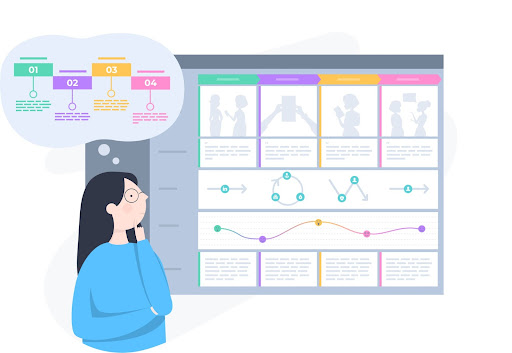
First, it’s important to decide which part of the employee experience journey you want to start with. At this point, there are a couple of routes you may take:
- High-level mapping. Obviously, it simply would take too much time to map the entire journey, as the employee lifecycle is way too long for one map. Unless you want to start with a high-level map and dive into details later as you dig more information. The downside of a high-level approach is that you won't get a lot out of it. The formula is fewer details = fewer insights.
- Focus on a specific part of the journey. It would be a whole lot easier to start with something like onboarding. The best part about onboarding is that if you are an HR, you have just enough knowledge to take the first steps.
- Identify the most problematic stage and start with it. However, it’s not that easy to tell which part is the most problematic without running research.
Employee journey stages
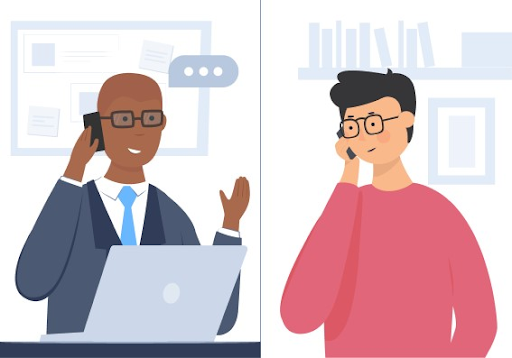
As we’ve touched the employee journey stages, let’s consider some of the common ones to give you an idea of what to include in your employee experience journey map.
- Attraction. This is the beginning of the journey, where potential employees first encounter the company brand or job opening. They form initial impressions about the company culture and values, and these impressions are often influenced by the company website, social media presence, and employer reviews.
- Recruitment. The potential employee actively considers the job opening and applies for a position. This stage may encompass submitting applications, attending interviews, and communicating with the company's hiring team.
- Hiring. This is when you make the job offer, and the candidate accepts it.
- Onboarding. The new employee starts their job, they get oriented and integrated into the organization. They learn about company policies, may undergo training for their specific role, and start building relationships with the team and managers.
- Development. This stage involves the employee's growth within the organization. It includes receiving feedback, pursuing professional development opportunities, and potentially participating in mentoring or coaching programs.
- Advancement. This is when the employee moves up within the company hierarchy through promotions or transfers.
- Exit. This is the final stage of the employee journey when the employee leaves the organization, whether for retirement, a new job, or other reasons. The exit process can include such substages as exit interviews, knowledge transfer, and the employee's transition out of the company.
Looking for more information about employee journey stages to add to your model of journey map? Check out our deck of cheat cards to look deeper into the stages and substages of employee journeys.
Three steps in designing an employee journey map
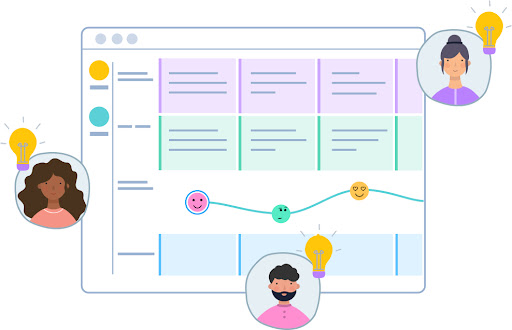
Now, we will cover the basic steps for creating a full-fledged, true-to-love employee journey map.
Start with employee experience research
Employee research, often referred to as employee surveys or employee feedback programs, is of paramount importance for organizations across various industries.
It involves collecting, analyzing, and acting upon feedback from employees to gain insights into their experiences, attitudes, and needs within the workplace. Here are some key reasons why employee research is important:
- It enhances employee engagement. By understanding what engages or disengages employees, organizations can take targeted actions to boost engagement.
- It supports informed decision-making. Employee research provides quantifiable insights, allowing leaders to allocate resources more effectively and prioritize initiatives that matter most to employees.
- It helps measure progress. By conducting surveys periodically, organizations can track progress over time. They can see how their efforts to address employee concerns and improve the workplace have translated into tangible results.
In other words, employee research is a strategic tool that empowers organizations to create better workplaces, improve employee satisfaction, increase productivity, and drive overall success. It aligns the interests of employees and employers, contributing to a positive organizational culture and sustainable growth.

So, you should always start with profound research. Otherwise, what exactly are we going to put on that map? And when it comes to interviewing employees, some really nice factors contribute to great research:
- Employees are easy to get in touch with, and such research is inexpensive compared to customer research. Imagine a situation where you have to bring a bunch of customers for a focus group or an interview. Each has a different time availability and level of involvement. Plus, chances are they might want to have something in return. Whereas, employees are almost always there and ready to share their thoughts over a cup of coffee.
- You have lots of data already. If you’ve been working in the company for a while, there’s probably enough information for you to start with employee journey mapping. And you can always talk to the HR department to get this information.
- Co-creation opportunities. There is nothing better than inviting coworkers for a journey mapping workshop. And again, it’s much easier within a company than when you’re trying to bring in real customers.
In addition to employee feedback and interviews, it may also be helpful to review internal audit reports to gain a better understanding of potential areas for improvement in the employee experience journey.
Surely, there will be a conflict of interests and ethics issues, so be ready to get creative!
Sources
Before doing any kind of research, make sure you come up with a list of sources. They can be:
- Employee feedback. If you are an HR, chances are you have a lot of info on hand that can be used for employee experience mapping.
- Interviews with employees. Trust me, they have so much to say, and chances are they wanted to say it years ago.
- Interviews with managers. They observe employees and are able to give you a whole different perspective on things.
- Polls and surveys. Those can give a lot of quantitative data. And the best part is that polls can be anonymous.
Produce an employee persona
To truly empathize with employees, it’s vital to create an employee persona. It is a made-up person that is based on real employees. It should have some basic description as well as some of the details you found during the research phase: goals, motivations and frustrations, some background, and maybe even skills.
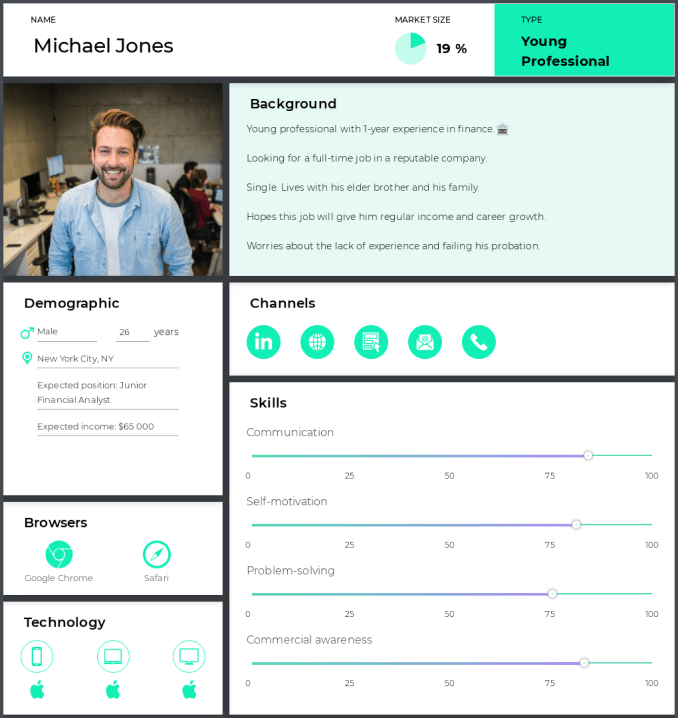
Meet Michael, our example, a young finance professional in the heart of NYC. With a year's experience under his belt, he aspired to land a job in a prestigious firm. Living with his brother's family in their cozy apartment, he found solace in their company but yearned for his own space. His daily routine includes job hunting between work, and his mind is always set on reaching the top of the corporate ladder.
You can have one, two, or multiple personas depending on your needs. To create your own persona, here's our guide with examples of how to create a persona in 7 steps.
Map the employee experience journey
Now, after the research has been done and personas have been created, it’s time to put everything on a map. The way you map an employee experience journey is the following:
- Define the stages you need for your map
If we talk about the journey part that covers a new employee onboarding, there will be stages like awareness, research, first contact, phone screening, job interview, the hiring process, the first day, the list goes on. It is very likely that some stages will have multiple substages (especially the hiring process and job interview).
- Decide on map layers or sections
These are layers of data you want to have on your map. Some of the commonly used journey map layers include employee goals, employee expectations, emotional experience, process, channels, touchpoints, and problems.
- Map it out
For each stage you defined, fill in the map sections with data about this stage. For example, write down the goals of the employee persona as well as their expectations or describe the process the employee persona goes through at each stage.
Feel free to add anything that can benefit you in the search for employee experience insights. If you feel like adding some quotes from real employees — it's great. Want to add a photo of the workplace for a new employee? Go ahead!
In fact, if you're mapping employee experience in our journey mapping tool, multiple sections will help you capture all the details you might want to have in your map!
- Find flaws and come up with solutions
Once you see the whole picture, you can start looking for roadblocks that prevent employees from, for example, getting the best onboarding experience.
Once you put roadblocks on the map, you can come up with ideas and solutions. In the end, you will have a map that looks somewhat like this:
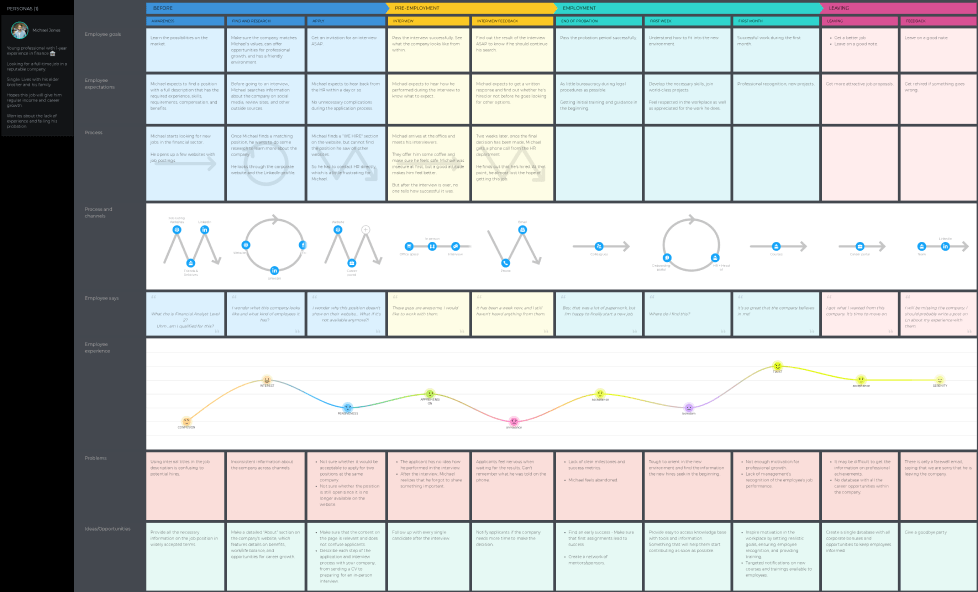
What’s next?
Once the journey map has been created, it serves as a valuable foundation for a positive employee experience. To ensure that their experience continually improves and stays aligned with the evolving needs of your company, consider the following actions:
- Collect ongoing feedback. Encourage employees to provide feedback throughout their journey. This can be done through surveys, one-on-one discussions, or anonymous feedback channels. This feedback should be used to identify pain points and areas for improvement.
- Regularly update the map. As processes and procedures change within your organization, update the map accordingly. This ensures that it remains an accurate reflection of the journey and can guide improvements effectively.
- Implement quick wins. Identify low-hanging fruit or quick wins based on the map insights. These are small, immediate changes that can significantly improve the experience without requiring extensive resources or time.
- Prioritize key touchpoints. Focus on the most critical touchpoints in the journey that have the greatest impact on the employee experience. Allocate resources and efforts to improve these areas first.
- Involve cross-functional teams. Collaborate with HR, IT, training, and other departments to address issues and implement changes. A cross-functional approach ensures a holistic perspective and comprehensive solutions.
- Set clear objectives. Define specific goals and objectives for improving the employee experience. This provides a clear direction for change initiatives and helps measure their success.
- Training and development. Invest in training and development programs for managers and mentors involved in onboarding. Equip them with the skills and knowledge needed to support the company’s employees effectively.
- Leverage technology. Use technology to streamline and automate parts of the onboarding process. This can reduce administrative burdens and create a more seamless experience for new hires.
- Monitor progress. Continuously monitor the impact of changes on the employee experience. Key performance indicators (KPIs) should be tracked and analyzed to ensure that improvements are achieving the desired outcomes.
- Employee involvement. Involve new employees in the co-creation of their onboarding journey. Seek their input and preferences to tailor the process to individual needs.
- Celebrate successes. Acknowledge and celebrate successes and improvements at different stages of your employees’ journey. Positive reinforcement can motivate teams to keep making enhancements.
- Stay compliant. Ensure that the onboarding process remains compliant with all relevant laws and regulations. Regularly review and update documentation as needed.
- Communication and transparency. Maintain open and transparent communication with employees regarding changes in the onboarding process. Provide clear explanations and expectations to manage their experience effectively.
Remember, journey mapping is not a one-time activity; it should evolve alongside your company's growth and changing needs. By actively listening to employee feedback, making data-driven decisions, and continually refining the onboarding experience, your organization can create a positive and impactful journey for new employees from day one.
Wrapping up
Mapping the employee experience is undoubtedly a challenging undertaking, one that demands a significant amount of effort, time, and resources. However, the rewards that come with creating an exceptional workplace environment and a satisfied workforce are simply too compelling to ignore.
Good news: we have a library of free templates, including employee experience map templates, which you can use for high-level mapping. Either download a PDF file and print it out or create a map in our Journey Mapping Tool, tweak it as you like, and then export it to show all the insights you came up with!



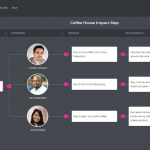

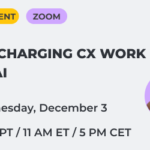
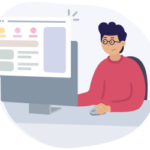
Thanks for the map. It’s a great template to start with for my company’s employee journey.
You’re welcome, Chris! We also have templates for remote employee journey and an employee journey mapping whitepaper with expert advice. Be sure to check those out and happy mapping!
Thank you for these employee journey mapping examples. Our problem is not so much with onboarding but with keeping people from leaving after 6-8 months. Do you have any advice on how to improve retention in the long run?
Hi Tarik, you’re welcome! We do have some employee experience examples you could use for better retention, and a detailed breakdown of common stages people go after the probation period is over: annual performance evaluation, office events, paternity leave, skill upgrading, etc.
You can find them all in our filled-out template called “End-to-end employee journey map” right here: https://uxpressia.com/templates/education-and-career